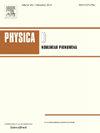grokking的复杂性动力学
IF 2.9
3区 数学
Q1 MATHEMATICS, APPLIED
引用次数: 0
摘要
我们通过研究grokking现象证明了神经网络中存在复杂性相变,即网络在训练数据过拟合后很长一段时间内突然从记忆过渡到泛化。为了描述这种相变,我们引入了一种基于率失真理论和Kolmogorov复杂度的测量复杂性的理论框架,可以将其理解为网络的原则有损压缩。我们发现适当正则化的网络表现出一个急剧的相变:在记忆过程中复杂性上升,然后随着网络发现一个更简单的基础模式而下降。相反,非正则化网络仍然困在高复杂性的记忆阶段。我们在复杂度度量和泛化界之间建立了明确的联系,为有损压缩和泛化之间的联系提供了理论基础。我们的框架实现的压缩比naïve方法好30-40倍,能够精确跟踪复杂性动态。最后,我们引入了一种基于谱熵的正则化方法,该方法通过惩罚网络的固有维数来鼓励网络向低复杂度表示方向发展。本文章由计算机程序翻译,如有差异,请以英文原文为准。
The complexity dynamics of grokking
We demonstrate the existence of a complexity phase transition in neural networks by studying the grokking phenomenon, where networks suddenly transition from memorization to generalization long after overfitting their training data. To characterize this phase transition, we introduce a theoretical framework for measuring complexity based on rate–distortion theory and Kolmogorov complexity, which can be understood as principled lossy compression for networks. We find that properly regularized networks exhibit a sharp phase transition: complexity rises during memorization, then falls as the network discovers a simpler underlying pattern that generalizes. In contrast, unregularized networks remain trapped in a high-complexity memorization phase. We establish an explicit connection between our complexity measure and generalization bounds, providing a theoretical foundation for the link between lossy compression and generalization. Our framework achieves compression ratios 30-40 better than naïve approaches, enabling precise tracking of complexity dynamics. Finally, we introduce a regularization method based on spectral entropy that encourages networks toward low-complexity representations by penalizing their intrinsic dimension.
求助全文
通过发布文献求助,成功后即可免费获取论文全文。
去求助
来源期刊

Physica D: Nonlinear Phenomena
物理-物理:数学物理
CiteScore
7.30
自引率
7.50%
发文量
213
审稿时长
65 days
期刊介绍:
Physica D (Nonlinear Phenomena) publishes research and review articles reporting on experimental and theoretical works, techniques and ideas that advance the understanding of nonlinear phenomena. Topics encompass wave motion in physical, chemical and biological systems; physical or biological phenomena governed by nonlinear field equations, including hydrodynamics and turbulence; pattern formation and cooperative phenomena; instability, bifurcations, chaos, and space-time disorder; integrable/Hamiltonian systems; asymptotic analysis and, more generally, mathematical methods for nonlinear systems.
 求助内容:
求助内容: 应助结果提醒方式:
应助结果提醒方式:


